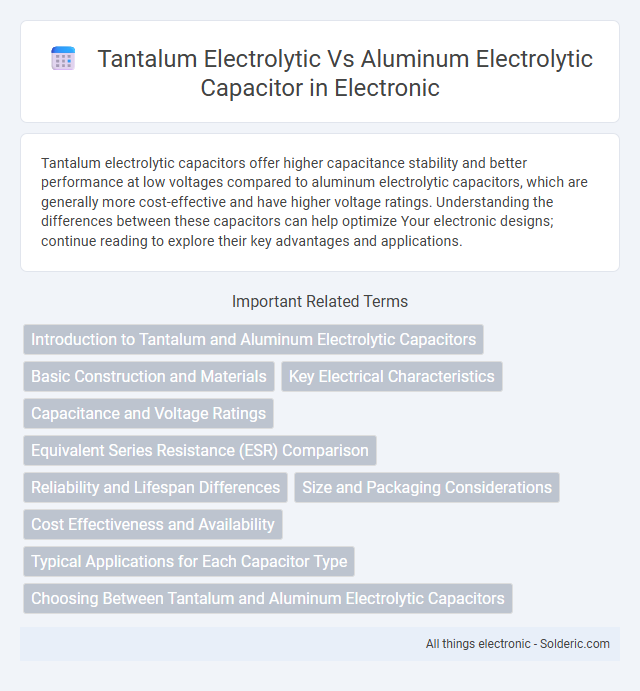Tantalum electrolytic capacitors offer higher capacitance stability and better performance at low voltages compared to aluminum electrolytic capacitors, which are generally more cost-effective and have higher voltage ratings. Understanding the differences between these capacitors can help optimize Your electronic designs; continue reading to explore their key advantages and applications.
Comparison Table
| Feature | Tantalum Electrolytic Capacitor | Aluminum Electrolytic Capacitor |
|---|---|---|
| Dielectric Material | Tantalum Pentoxide (Ta2O5) | Aluminum Oxide (Al2O3) |
| Capacitance Range | 0.1uF to 470uF | 1uF to 100,000uF |
| Voltage Rating | 2V to 50V | 6.3V to 500V |
| Equivalent Series Resistance (ESR) | Low ESR (better performance) | Higher ESR |
| Leakage Current | Lower leakage current | Higher leakage current |
| Temperature Range | -55degC to +125degC | -40degC to +85degC |
| Polarization | Polarized | Polarized |
| Reliability | High reliability, sensitive to surge voltages | Moderate reliability, more tolerant to voltage spikes |
| Size | Smaller size for given capacitance and voltage | Larger size for equivalent capacitance |
| Cost | Higher cost | Lower cost |
| Common Applications | Audio equipment, precision circuits, space-limited designs | Power supplies, general electronic devices, filtering |
Introduction to Tantalum and Aluminum Electrolytic Capacitors
Tantalum electrolytic capacitors utilize tantalum pentoxide as the dielectric, offering high capacitance per volume and excellent stability over temperature, making them ideal for miniaturized and high-reliability applications. Aluminum electrolytic capacitors employ an aluminum oxide layer as the dielectric, typically providing higher capacitance values and cost-effective solutions for power supply filtering and bulk energy storage. Both types differ in their equivalent series resistance (ESR), leakage current, and voltage ratings, influencing their performance in specific electronic circuits.
Basic Construction and Materials
Tantalum electrolytic capacitors feature a tantalum metal anode coated with a layer of tantalum pentoxide dielectric, providing high capacitance per volume due to the stable and thin oxide layer. Aluminum electrolytic capacitors utilize an aluminum foil anode with an aluminum oxide dielectric layer formed through anodizing, combined with a liquid or solid electrolyte to maintain conductivity and functionality. The choice of materials influences performance characteristics such as leakage current, equivalent series resistance (ESR), and operating temperature ranges.
Key Electrical Characteristics
Tantalum electrolytic capacitors offer higher capacitance per volume and lower equivalent series resistance (ESR) compared to aluminum electrolytic capacitors, making them ideal for applications requiring stable performance and low ripple currents. Aluminum electrolytic capacitors provide higher voltage ratings and better surge current tolerance, suitable for power supply filtering with higher load demands. Your choice depends on balancing capacitance density, voltage requirements, and ESR specifications critical to circuit reliability and efficiency.
Capacitance and Voltage Ratings
Tantalum electrolytic capacitors typically offer higher capacitance per volume and stable capacitance values over a wide voltage range, making them ideal for compact designs requiring reliable performance. Aluminum electrolytic capacitors generally provide higher voltage ratings and are available in larger capacitance values but tend to have larger physical sizes and lower capacitance stability. Your choice should depend on the specific voltage and capacitance requirements of your application, balancing size constraints and performance stability.
Equivalent Series Resistance (ESR) Comparison
Tantalum electrolytic capacitors typically exhibit lower Equivalent Series Resistance (ESR) compared to aluminum electrolytic capacitors, resulting in better performance in high-frequency applications. The lower ESR in tantalum capacitors enhances efficiency, thermal stability, and reduces power dissipation in circuits. However, aluminum capacitors offer a broader range of capacitance values and higher voltage ratings at a generally lower cost despite their higher ESR.
Reliability and Lifespan Differences
Tantalum electrolytic capacitors offer superior reliability with stable capacitance and low ESR, making them ideal for long-term applications in aerospace and medical equipment. Aluminum electrolytic capacitors generally have shorter lifespans due to higher electrolyte evaporation rates and sensitivity to temperature variations, resulting in reduced performance over time. The self-healing property of tantalum capacitors enhances lifespan and failure resistance, whereas aluminum capacitors require careful derating to maintain durability in demanding environments.
Size and Packaging Considerations
Tantalum electrolytic capacitors offer a significantly smaller size and higher volumetric efficiency compared to aluminum electrolytic capacitors, making them ideal for compact electronic designs. Their solid tantalum oxide dielectric allows for stable capacitance in a compact package, often resulting in lower equivalent series resistance (ESR) and better performance in high-frequency applications. Aluminum electrolytic capacitors typically require larger packaging to achieve equivalent capacitance and voltage ratings, which limits their use in size-sensitive or high-density PCBs.
Cost Effectiveness and Availability
Tantalum electrolytic capacitors typically offer higher capacitance stability and longer lifespan but come at a higher cost and limited availability due to the scarcity of tantalum ore. Aluminum electrolytic capacitors are more cost-effective and widely available, making them an economical choice for applications where large capacitance values are required without stringent performance demands. Your project's budget and supply chain considerations often determine the best capacitor type to ensure cost efficiency and consistent availability.
Typical Applications for Each Capacitor Type
Tantalum electrolytic capacitors excel in space-constrained applications requiring stable capacitance and low ESR, such as in smartphones, medical devices, and military electronics. Aluminum electrolytic capacitors are preferred for power supply filtering, audio equipment, and industrial machinery due to their high capacitance and voltage ratings. Your choice depends on balancing size, reliability, and electrical performance tailored to the specific application demands.
Choosing Between Tantalum and Aluminum Electrolytic Capacitors
Choosing between tantalum and aluminum electrolytic capacitors depends on your project's requirements for size, reliability, and performance. Tantalum capacitors offer higher capacitance per volume and better stability under temperature changes, making them ideal for space-constrained, high-reliability applications. Aluminum electrolytic capacitors, while larger and less stable, provide cost-effective high capacitance options suitable for power supply filtering and general-purpose use.
tantalum electrolytic vs aluminum electrolytic capacitor Infographic

 solderic.com
solderic.com